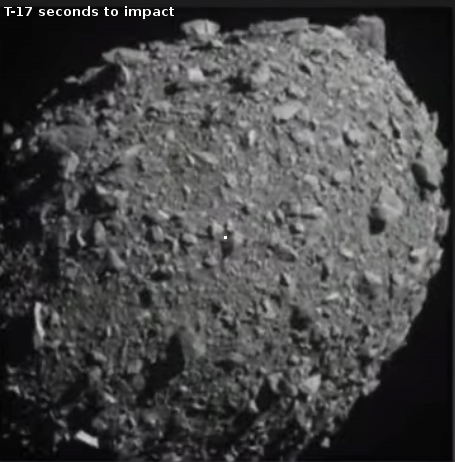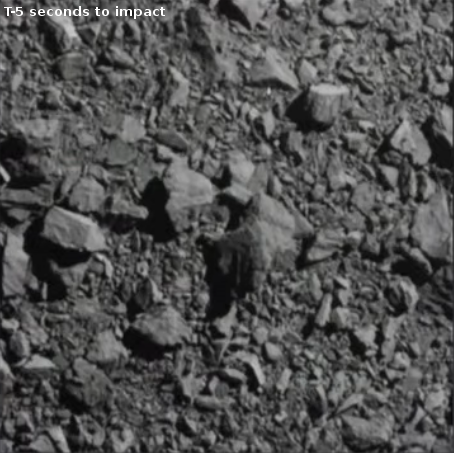DART hits Dimorphus



The probe DART today successfully impacted the small 525-foot-wide asteroid Dimorphus. From the data produced engineers will calculate how much that impact changed Dimorphus’ orbit around it parent asteroid, half-mile-wide Didymos.
The three images to the right give a sense of the approach and impact.
The first, at 2 minutes and 30 seconds from impact, shows Didymos in the left bottom corner. You can actually see individual boulders on its surface. At this distance and resolution is is unclear whether it is a rubble pile or a more solid body. Dimorphus is no longer a mere dot, but no surface features can yet be discerned.
The second image, only seventeen seconds before DART crashed into Dimorphus, shows us the entire asteroid. Though it appears to be a pile of rocks, it also appears less of a rubble pile than both Ryugu and Bennu, visited by probes in 2019 and 2020. Those rubble-piles had almost no smooth surface areas. Dimorphus however at this distance and resolution does appear to have a lot of areas where the surface is relatively smooth, suggesting its structure is more solid than a rubble pile.
At only 525 feet across, some of those bigger boulders are about 50 to 60 feet in diameter.
The white dot in the center of Dimorphus marks the rocks seen in the third image, taken about five seconds before impact. At this resolution so close to the surface, it appears the smooth areas are actually made up of many tiny pebbles and dust.
The biggest rock in the center of the picture is probably between ten to twenty feet in diameter.
The primary data from this mission will not be available for a few weeks. Scientists have to observe both asteroids to see how much, if at all, Dimorphus’s orbit was shifted by the impact. Also, the images from the Italian cubesat, LICIACube Explorer, which was flying parallel to DART and taking pictures of the impact, plume, and back side of Dimorphus, won’t be available until later this week. Those images should give us a measure of the spacecraft’s effect on the asteroid. They will also reveal a lot more about the asteroid’s geology.
On Christmas Eve 1968 three Americans became the first humans to visit another world. What they did to celebrate was unexpected and profound, and will be remembered throughout all human history. Genesis: the Story of Apollo 8, Robert Zimmerman's classic history of humanity's first journey to another world, tells that story, and it is now available as both an ebook and an audiobook, both with a foreword by Valerie Anders and a new introduction by Robert Zimmerman.
The print edition can be purchased at Amazon or from any other book seller. If you want an autographed copy the price is $60 for the hardback and $45 for the paperback, plus $8 shipping for each. Go here for purchasing details. The ebook is available everywhere for $5.99 (before discount) at amazon, or direct from my ebook publisher, ebookit. If you buy it from ebookit you don't support the big tech companies and the author gets a bigger cut much sooner.
The audiobook is also available at all these vendors, and is also free with a 30-day trial membership to Audible.
"Not simply about one mission, [Genesis] is also the history of America's quest for the moon... Zimmerman has done a masterful job of tying disparate events together into a solid account of one of America's greatest human triumphs."--San Antonio Express-News



The probe DART today successfully impacted the small 525-foot-wide asteroid Dimorphus. From the data produced engineers will calculate how much that impact changed Dimorphus’ orbit around it parent asteroid, half-mile-wide Didymos.
The three images to the right give a sense of the approach and impact.
The first, at 2 minutes and 30 seconds from impact, shows Didymos in the left bottom corner. You can actually see individual boulders on its surface. At this distance and resolution is is unclear whether it is a rubble pile or a more solid body. Dimorphus is no longer a mere dot, but no surface features can yet be discerned.
The second image, only seventeen seconds before DART crashed into Dimorphus, shows us the entire asteroid. Though it appears to be a pile of rocks, it also appears less of a rubble pile than both Ryugu and Bennu, visited by probes in 2019 and 2020. Those rubble-piles had almost no smooth surface areas. Dimorphus however at this distance and resolution does appear to have a lot of areas where the surface is relatively smooth, suggesting its structure is more solid than a rubble pile.
At only 525 feet across, some of those bigger boulders are about 50 to 60 feet in diameter.
The white dot in the center of Dimorphus marks the rocks seen in the third image, taken about five seconds before impact. At this resolution so close to the surface, it appears the smooth areas are actually made up of many tiny pebbles and dust.
The biggest rock in the center of the picture is probably between ten to twenty feet in diameter.
The primary data from this mission will not be available for a few weeks. Scientists have to observe both asteroids to see how much, if at all, Dimorphus’s orbit was shifted by the impact. Also, the images from the Italian cubesat, LICIACube Explorer, which was flying parallel to DART and taking pictures of the impact, plume, and back side of Dimorphus, won’t be available until later this week. Those images should give us a measure of the spacecraft’s effect on the asteroid. They will also reveal a lot more about the asteroid’s geology.
On Christmas Eve 1968 three Americans became the first humans to visit another world. What they did to celebrate was unexpected and profound, and will be remembered throughout all human history. Genesis: the Story of Apollo 8, Robert Zimmerman's classic history of humanity's first journey to another world, tells that story, and it is now available as both an ebook and an audiobook, both with a foreword by Valerie Anders and a new introduction by Robert Zimmerman.
The print edition can be purchased at Amazon or from any other book seller. If you want an autographed copy the price is $60 for the hardback and $45 for the paperback, plus $8 shipping for each. Go here for purchasing details. The ebook is available everywhere for $5.99 (before discount) at amazon, or direct from my ebook publisher, ebookit. If you buy it from ebookit you don't support the big tech companies and the author gets a bigger cut much sooner.
The audiobook is also available at all these vendors, and is also free with a 30-day trial membership to Audible.
"Not simply about one mission, [Genesis] is also the history of America's quest for the moon... Zimmerman has done a masterful job of tying disparate events together into a solid account of one of America's greatest human triumphs."--San Antonio Express-News


When will “color commentators” learn to shut up and let people listen, at the very least in the last minute or so?!
DART has made History!
A huge win for Planetary Defense & in the next weeks we’ll evaluate the results of the impact.
I wonder how many Astronomers are at their Telescopes now starting their observations measuring how much the orbit of asteroid Dimorphos changed after impact of NASA’s DART spacecraft.
Mr. Z – any insight as to the involvement of Hubble & the Lucy Spacecraft in those measurements?
ST: Original Series
“Spock explains the Asteroid Situation”
https://youtu.be/T8_-CBCzDVU
1:41
During the late stages of the approach, someone in Mission Control said the “miss distance” was 17 meters. Since the center of mass could certainly only be derived from the optical profile of the target, I think we can safely proclaim it a “bullseye”! Nice work, APL!
(Rubble pile belches after swallowing tiny Earth probe)
I’m glad to live at a time when all those broken rock fragments aren’t still being made in such great numbers.
Ray, Totally agree. I often jist turn the sound off and let the story tell itself
I saw a short clip of the impact from an Earth-based telescope and the cloud of debris was impressive, especially the speed at which it expanded, which implies a lot of momentum was transferred!
One problem was that the clip I saw had no indication of the direction from which the probe approached, so you don’t know if the cloud was ejected from the impact crater back toward the direction of impact, or off the “back” of the target in the direction of impact. Anyone have any better info?
Ray Van Dune: Can you provide a link to this imagery?
But the most important question: Was anyone wearing a found-to-be-inappropriate shirt?
Ray Van Dune: Found it, and have posted a link.
First photos are in from LICIACube. https://gizmodo.com/liciacube-images-dart-asteroid-impact-1849585958